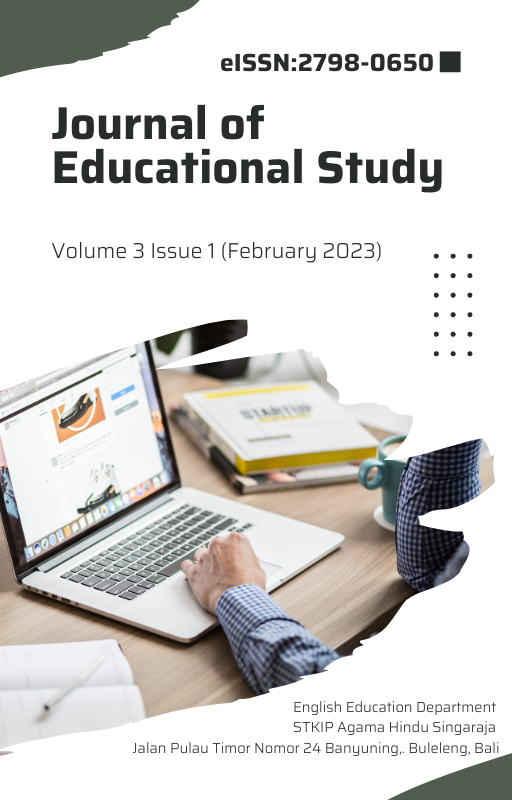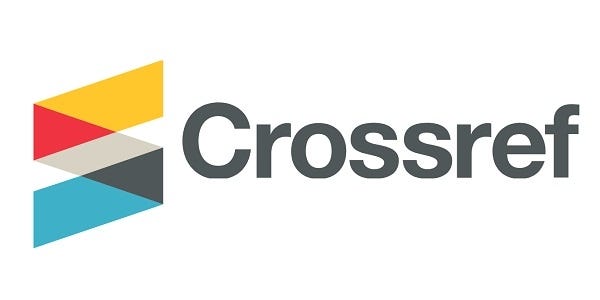Students’ Creative Process in Writing a Feature: A Critical Analysis
DOI:
https://doi.org/10.36663/joes.v3i1.425Keywords:
Creative Process, Creative Writing, Feature WrtingAbstract
In creative writing, the process of student develops the idea into a piece of features becomes an emphasis rather than the final result. The student who made a feature writing certainly needs to pass the process in order to make a good feature writing. This study aimed at analysing the creative process of that experienced by students in writing feature writing in creative writing class and their creative process that is reflected in their creative writing. It was a qualitative study especially a case study, in which the data were collected and described through phenomena that were found on the creative process of the student in creating their feature writing. The finding of the study revealed all of the students passed seven stages of the creative process. All of the seven stages were preparation, planning, incubation, beginning flowing, breakthrough, and titling. One of the respondents missed the planning stages because that respondent write the feature directly without making a draft first. The result of the study implies that creative writing is different from common writing in terms of the process. Teachers are encouraged to help students to give suggestions and feedback during students’ creative writing process.
Downloads
References
Ahmad, D. (2014). Understanding the 2013 curriculum of English teaching through the teachers’ and policymakers’ perspectives. International Journal of Enhanced Research in Educational Development (IJERED), 2(4), 6–15.
Aisah, H., Mansur, A. S., & Yulianti, Z. Q. (2020). HOTS LEARNING IN PANDEMIC OF COVID-19 PERIOD THROUGH DEEP LEARNING MODEL. International Journal of Graduate of Islamisc Education, 1(2), 96–115.
Anderson, L. W. &, & Krathwohl, D. R. (2001). A taxonomy for learning, teaching, and assessing, Abridged Edition (Abridged E). Boston: MA: Allyn and Bacon.
Creswell, J. W. (2009). Research design: qualitative, quantitative, and mixed methods approaches (3rd editio). Thousand Oaks, CA: Sage Publications.
Driana, E., & Ernawati, E. (2019). Teachers’ Understanding and Practices in Assessing Higher Order Thinking Skills at Primary Schools. ACITYA Journal of Teaching & Education, 1(2), 110–118.
Fatimahtuzzahroh, A. M., Mustadi, A., & Wangid, M. N. (2021). Jurnal Pendidikan Progresif Implemetation HOTS Based-Learning During Covid-19 Pandemic in. Jurnal Pendidikan Progresif, 11(1), 96–111. https://doi.org/10.23960/jpp.v11.i1.20210
Feronica, R. A., Apriani, E., & Edy, S. (2021). The Implementation of Higher Order Thinking Skill (HOTS) in Junior High School: Teaching Practice and Problems. ENGLISH FRANCA : Academic Journal of English Language and Education, 5(2), 185. https://doi.org/10.29240/ef.v5i2.2589
Giri, P. A. L. P. N. (2021). Teachers’ Perception of HOTS-Based Learning in EFL Classroom. The Art of Teaching English as a Foreign Language, 2(2), 103–108. https://doi.org/10.36663/tatefl.v2i2.122
Margana, M., & Widyantoro, A. (2017). Developing English Textbooks Oriented to Higher Order Thinking Skills for Students of Vocational High Schools in Yogyakarta. Journal of Language Teaching and Research, 8(1), 26. https://doi.org/10.17507/jltr.0801.04
Miles, B., Huberman, M., & Saldana, J. (2014). Qualitative Data Analysis: A Methods Sourcebook. Sage Publications.
Parimaladevi, P., & Ahmad, A. (2019). The implementation of Higher-Level Thinking Skills (HOTS) in History Education. Global Conferences Series: Social Sciences, Education and Humanities (GCSSSEH), 2, 216–220. https://doi.org/10.32698/gcs.01100
Purwaningsih, Y. R., Floriani, R., & Eva, D. (2021). Investigating EFL Students ’ Higher Order Thinking Skills ( HOTS ) via E-Learning During The Covid-19 Pandemic. Proceedings of the International Joined Conference on Social Science (ICSS 2021), 603(Icss), 512–516.
Retnawati, H., Djidu, H., Kartianom, Apino, E., & Anazifa, R. D. (2018). Teachers’ knowledge about higher-order thinking skills and its learning strategy. Problems of Education in the 21st Century, 76(2), 215–230. https://doi.org/10.33225/pec/18.76.215
Seman, S. C., Yusoff, W. M. W., & Embong, R. (2017). eachers Challenges in Teaching and Learning for Higher Order Thinking Skills (HOTS) in Primary School. International Journal of Asian Social Science, 7(7), 534–545. Retrieved from https://doi.org/10.18488/journal.1.2017.77.534.545
Setyowati, R., Sarwanto, & Muzzazinah. (2021). “How Students’s Higher Order Thinking Skills through E-Learning during the Covid-19 Pandemic? What does it have to do with University? “How Students’s Higher Order Thinking Skills through E-Learning during the Covid-19 Pandemic? What Does It Have to Do with University?, 1808(1). https://doi.org/10.1088/1742-6596/1808/1/012032.
Sitohang, M. N. M. (2020). Teaching English during Pandemic Covid-19 for the Secondary School Students in Palangka Raya. Proceedings of International …, 4432(October), 21–22. Retrieved from https://e-proceedings.iain-palangkaraya.ac.id/index.php/INACELT/article/view/130
Surya, C. I. R. P., Wedhanti, N. K., & Juniarta, P. A. K. (2021). Identification of Higher Order Thinking Skill Domain in the Eleventh Grade English Lesson Plan at SMK N 1 Singaraja. The Art of Teaching English as a Foreign Language, 2(1), 126–138. https://doi.org/10.36663/tatefl.v2i1.215
Wahyono, P. et. al. (2020). Guru professional di masa pandemic COVID-19: Review Implementasi, tantangan, dan solusi pembelajaran daring. Jurnal Pendidikan Profesi Guru, 1(1), 51–65. Retrieved from http://ejournal.umm.ac.id/index.php/jppg.
Wandyra, A. (2020). THE TEACHING OF ENGLISH AT JUNIOR HIGH SCHOOL. English Language Teaching Study Program Postgraduate School, Universitas of Islam Malang, Indonesia.
Warmadewi, P. S., Agustini, D. A. E., & Wedhanti, N. K. (2019). Analysis of Learning Higher Order Thinking Skill (HOTS) Toward English Subject. Jurnal Penelitian Dan Pengembangan Sains Dan Humaniora, 3(2), 134. https://doi.org/https://doi.org/10.23887/jppsh.v3i2.21278
Yoke, S. K., & Hashim, H. (2021). The Challenges of Implementing Higher Order Thinking Skills in Online Distance Learning. Proceeding of the 5th INACELT (International Conference on English Language Teaching, 4432(November 2021), 161–171. Retrieved from https://e-proceedings.iain-palangkaraya.ac.id/index.php/INACELT/article/view/714
Yuliati, S. R., & Lestari, I. (2018). Higher-Order Thinking Skills (Hots) Analysis of Students in Solving Hots Question in Higher Education. Perspektif Ilmu Pendidikan, 32(2), 181–188. https://doi.org/10.21009/pip.322.10
Downloads
Published
How to Cite
Issue
Section
License
Copyright (c) 2022 Kadek Sathya Sasmita

This work is licensed under a Creative Commons Attribution 4.0 International License.
https://creativecommons.org/licenses/by-sa/4.0/















